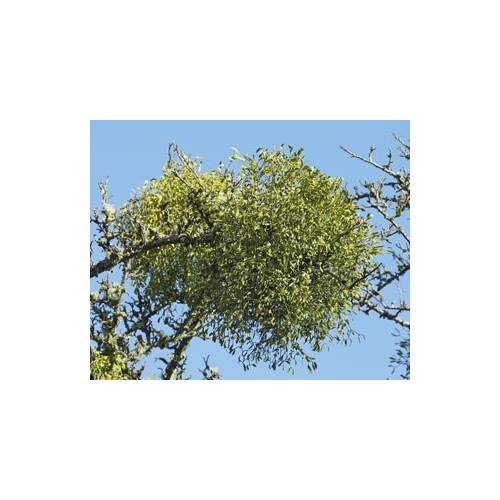
Parasites and insects
Mistletoe
- Details
-
Who has not come across an old apple tree entwined in mistletoe? This parasite may annoy us but it is not really a dangerous disease.
The symptoms
Mistletoe establishes itself easily and it is even easier to spot: a large ball of green branches covered in curious flat tough leaves, solidly hanging from a supporting branch. The vegetation of the tree does not appear to be affected by a single ball of mistletoe. However, old apple trees that have dozens of these mistletoe balls produce very little fruit.
Lifecycle
Before the mistletoe can manage to hang on to a branch, it has already gone through a long journey. It probably arrived on the tree as a grain that was left by a thrush, which had transported it in its stomach. The mistletoe develops very slowly, once it has successfully germinated under the bark, it will only form its first couple of leaves after the second year. Every subsequent year it will form another set of leaves, so it is quite easy to determine how old a ball of mistletoe is. It only steals the raw sap from the tree; this is water containing mineral salts which it transforms itself in to a more sophisticated sap. The inconvenience to the tree is strictly limited: it is as if the host tree is just deprived of a small root, therefore most trees manage to survive very well.
How to fight it
Given that the mistletoe does not threaten the life of the tree, it is not crucial that it must be eliminated if there are only one or two balls of it. Wanting to remove the mistletoe is more the reflex of the pernickety gardener than a necessity! In an old tree that is overrun with mistletoe then it is different. You must cut the infested branches at least 50cm away from the mistletoe. If the branches are cut too close to the base of the mistletoe it will often grow again. Whatever you do, do not use weed killer on the mistletoe, as it is the host plant that will die!
How to avoid it
There is absolutely no way to prevent the mistletoe arriving as the berries are carried in from a long way off by the birds. It is worth noting that this plant is very beneficial to birds in the winter. Not only does it feed the thrushes with its berries but also tits feed off the mistletoe grains that are germinating on the branches during a time in winter when food is scarce. Encouraging tits in the garden is without doubt the best way of stopping the mistletoe spreading!
Good to know
Mistletoe can grow on most trees, with the exception of the ash, on which it has never been seen. In gardens, this parasite can find a host among the many types of tree. There is a mistletoe just for conifers, quite rare and even less harmful than the variety found on leaved trees. - Photos (1)

